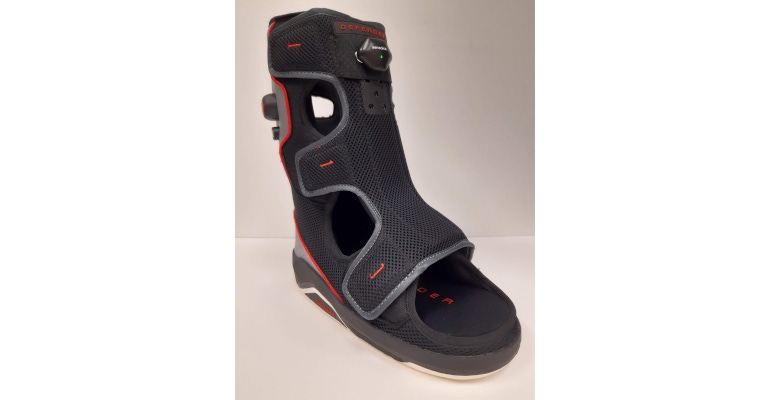Materials, Design, & Electronics Combine to Defend Against Diabetes
A specially designed, post-surgery, protective boot helps diabetes patients' leg wounds heal properly, reducing the risk of amputation. It also lets physicians remotely monitor patients' behavior and progress.
November 8, 2022

Wearable technologies have been used for all kinds of purposes, including energy harvesting and health monitoring. They usually combine sensors and other electronics with app-based data collection, sometimes enhanced by flexible electronic fabrics.
For example, Sensoria Health develops smart healthcare footwear and clothing, along with cloud-based remote patient monitoring electronics and software. These wearables collect data on the physical activity of gait-impaired patients.
Now, in partnership with foot care solutions provider Foot Defender, that expertise has been used to create the Foot Defender+ boot for diabetes patients. The removable boot is designed so patients will keep it on long enough after ulcer surgery for foot wounds to heal properly. Otherwise, sepsis can develop, and even the need to amputate a foot or the entire leg.
Materials, Electronics Provide Good Fit, Remote Diabetes Patient Monitoring
After ulcer surgery, keeping the wound clean and protected is critical. But most post-surgery boots are bulky and uncomfortable, so patients often disobey doctors' orders and remove them. "Since they can't feel pain they don't always know when damage is occurring, which prevents healing and makes the wound worse," said Sensoria co-founder and CEO Davide Vigano.
Sensoria and Foot Defender jointly designed and developed the smart protective boot with a shoe-like design, using the expertise of former Nike shoe designers and under the guidance of leading podiatrists. The boot's materials strike a balance among comfort, protection, and support, said Vigano. Carbon fiber nylon forms its structure, into which air is pumped for better fit. The boot also contains memory foam to relieve pressure and improve fit, while its outer sole is made from ethylenediamine for stability.
The Foot Defender+ securely holds a small module containing microelectronics that connect to an app Sensoria developed on a dedicated, Internet-connected smart watch.
"The watch app monitors patient's adherence and activity, crucial indicators to reduce the risk of amputation," Vigano said. "It gives uncomplicated, easy-to-understand behavioral feedback: for example, removing the boot during the day or too much walking produces a frownie face."
Doctors can remotely monitor their patient population through a secure, privacy-respectful browser dashboard to discover who's not complying. They can then phone these patients, or take other actions to aid healing, such as prescribing a scooter or, in some cases, making the boot non-removable.
"The Sensoria Core microelectronics in the Foot Defender+ boot consist of a 9-axis inertial measurement unit containing accelerometer, gyroscope, and magnetometer," said Vigano. "In addition, the IMU has an embedded Bluetooth Smart communication device, a charger, and a long-lasting rechargeable battery. The Android smart watch, with 4G LTE connectivity, contains another IMU, which allows us to compare the data."
Foot Defender+ Data May Help Kickstart the IoMe
The boot is being validated by the USC Keck School of Medicine and Baylor College of Medicine, under a grant from the National Institutes of Health. Sensoria is also sharing some of the huge amount of data generated by tracking patients' total-body movement and activity.
That's because there's very little information about the impact that different activities have on diabetic foot ulcers. "Since most wearable devices are worn on the wrist and engineered to collect data from people with a normal gait, we couldn't previously measure data from diabetic patients with foot or leg injuries," said Vigano. "So now we're using data from the boot to understand what levels and kinds of activity are too much and too little. We'll be able to look at patterns and predict whether a patient is on the right path to healing."
Vigano said that, although the Internet of Things (IoT) is generating lots of data from objects like houses and cars, there's still a limited amount coming from the human body. That new branch of technology is being dubbed, by some, the Internet of Me (IoMe) instead of the IoT.
"Imagine what we could do with data from garments and footwear?" he said. "It will help inform the diagnostic process of the next generation of clinicians."
About the Author(s)
You May Also Like



